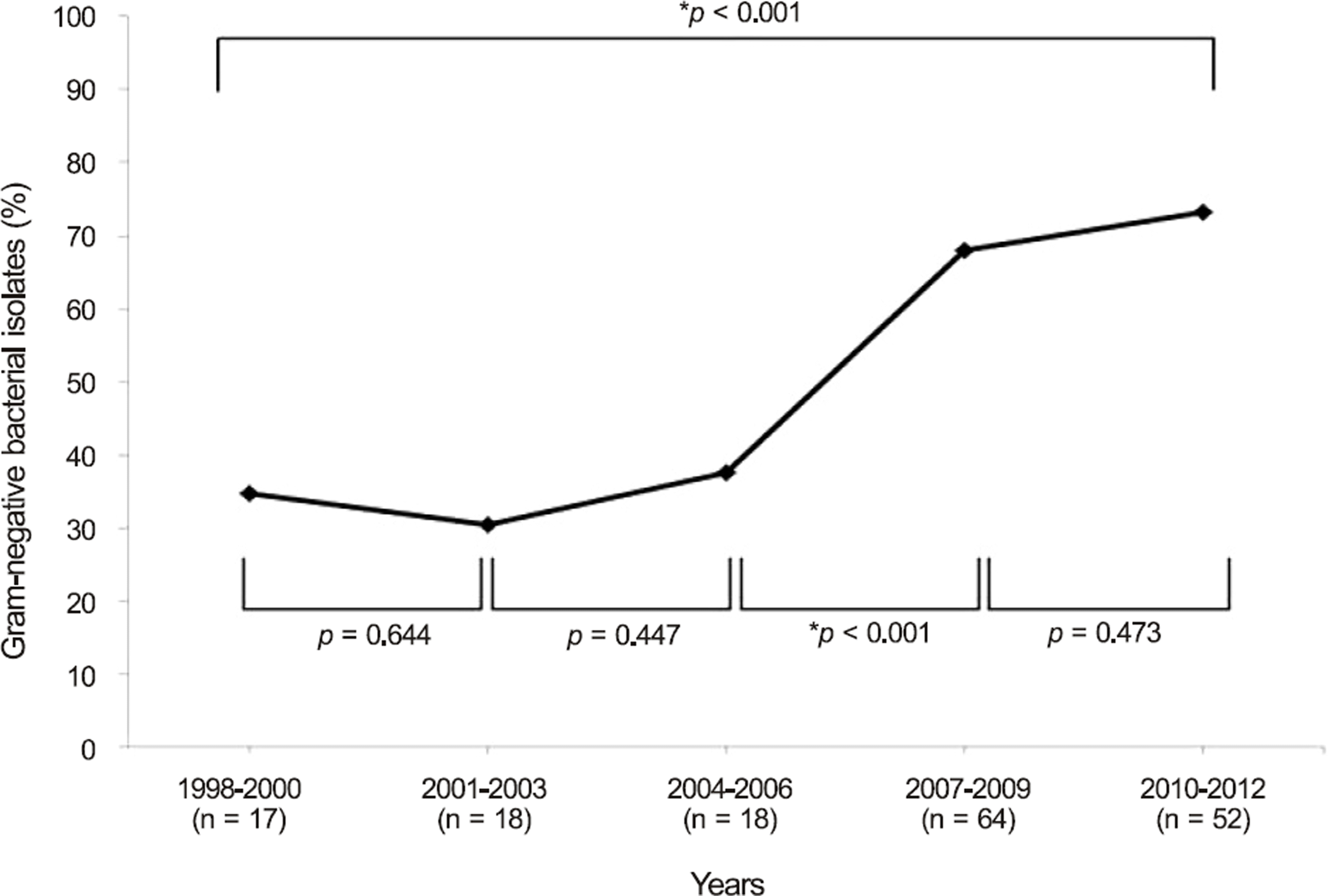1. Lichtinger A, Yeung SN, Kim P. . Shifting trends in bacterial keratitis in Toronto: an 11-year review. Ophthalmology. 2012; 119:1785–90.
2. Asbell P, Stenson S. Ulcerative keratitis. Survey of 30 years' labo-ratory experience. Arch Ophthalmol. 1982; 100:77–80.
3. Orlans HO, Hornby SJ, Bowler IC. In vitro antibiotic susceptibility patterns of bacterial keratitis isolates in Oxford, UK: a 10-year review. Eye (Lond). 2011; 25:489–93.

4. Hahn YH, Lee SJ, Hahn TW. . Antibiotic susceptibilities of ocular isolates from patients with bacterial ke ratitis: a Multi-center Study. J Korean Ophthalmol Soc. 1999; 40:2401–10.
5. Lim SH, Lee SB. Analysis of inpatients with bacterial keratitis over a 12-year period: pathogenic organisms and antibiotic resistance. J Korean Ophthalmol Soc. 2012; 53:372–84.

6. Kim WJ, Kweon EY, Lee DW. . Prognostic factor and anti-biotic susceptibility in bacterial keratitis: results of an eight-year period. J Korean Ophthalmol Soc. 2009; 50:1495–504.

7. Sun HJ, Lee JY, Kim SY, Jung MS. Clinical features of infectious keratitis in west coast area of Chungcheongnam-do, Korea. J Korean Ophthalmol Soc. 2010; 51:658–63.

8. Tuft SJ, Matheson M. In vitro antibiotic resistance in bacterial keratitis in London. Br J Ophthalmol. 2000; 84:687–91.

9. Fong CF, Hu FR, Tseng CH. . Antibiotic susceptibility of bacterial isolates from bacterial keratitis cases in a university hospital in Taiwan. Am J Ophthalmol. 2007; 144:682–9.

10. Toshida H, Kogure N, Inoue N, Murakami A. Trends in microbial keratitis in Japan. Eye Contact Lens. 2007; 33:70–3.

11. Park JH, Lee SB. Analysis on inpatients with infectious keratitis: causative organisms, clinical aspects and risk factors. J Korean Ophthalmol Soc. 2009; 50:1152–66.

12. Kim SJ, Lee SB. Analysis on elderly inpatients with infectious keratitis: causative organisms, clinical aspects, and risk factors. J Korean Ophthalmol Soc. 2010; 51:1554–67.

13. Kim JY, Yoon KC, Park YG. . Age-related clinical analysis of infectious keratitis in two tertiary centers. J Korean Ophthalmol Soc. 2010; 51:927–34.

14. Yoon JH, Jung JW, Moon HS. . Antibiotics susceptibility in bacterial keratitis and proper initial treatment. J Korean Ophthalmol Soc. 2013; 54:38–45.

15. Shin SY, Koo SH, Kwon KC. . Evaluation of the Vitek 2 Korean antimicrobial susceptibility testing cards AST N056 and AST N055. Korean J Clin Microbiol. 2008; 11:23–8.

16. Mukerji N, Vajpayee RB, Sharma N. Technique of area measure-ment of epithelial defects. Cornea. 2003; 22:549–51.

17. Biemer JJ. Antimicrobial susceptibility testing by the Kirby-Bauer disc diffusion method. Ann Clin Lab Sci. 1973; 3:135–40.
18. Jorgensen JH, Hindler JF. New consensus guidelines from the Clinical and Laboratory Standards Institute for antimicrobial sus-ceptibility testing of infrequently isolated or fastidious bacteria. Clin Infect Dis. 2007; 44:280–6.

19. Green MD, Apel AJ, Naduvilath T, Stapleton FJ. Clinical out-comes of keratitis. Clin Experiment Ophthalmol. 2007; 35:421–6.

20. Kim MR, Lee SB. Clinical and microbiological analysis of Gram- positive bacterial keratitis, a 15-year review. J Korean Ophthalmol Soc. 2014; 55:1432–44.
21. Zhang C, Liang Y, Deng S. . Distribution of bacterial keratitis and emerging resistance to antibiotics in China from 2001 to 2004. Clin Ophthalmol. 2008; 2:575.
22. Hahn YH, Hahn TW, Tchah H. . Epidemiology of infectious keratitis(II): a Multi-center Study. J Korean Ophthalmol Soc. 2001; 42:247–65.
23. Cho CH, Lee SB. Analysis of inpatients with contact lens related bacterial keratitis: causative microorganisms, clinical aspects, and prognostic factors. J Korean Ophthalmol Soc. 2013; 54:1327–38.

24. Green M, Apel A, Stapleton F. A longitudinal study of trends in keratitis in Australia. Cornea. 2008; 27:33–9.

25. Afshari NA, Ma JJ, Duncan SM. . Trends in resistance to cipro-floxacin, cefazolin, and gentamicin in the treatment of bacterial keratitis. J Ocul Pharmacol Ther. 2008; 24:217–23.

26. Yeh DL, Stinnett SS, Afshari NA. Analysis of bacterial cultures in infectious keratitis, 1997 to 2004. Am J Ophthalmol. 2006; 142:1066–8.

27. Mantadakis E, Maraki S, Michailidis L. . Antimicrobial sus-ceptibility of Gram-positive cocci isolated from patients with con-junctivitis and keratitis in Crete, Greece. J Microbiol Immunol Infect. 2013; 46:41–7.

28. Ahn G, Hahn YH, Lee HB. Serratia marcescens keratitis. J Korean Ophthalmol Soc. 2002; 43:658–64.
29. Hahn YH, Lee SJ, Hahn YW. . Epidemiology of Pseudomonas keratitis: a multi center study. J Korean Ophthalmol Soc. 1999; 40:2411–22.
30. Tchah H, Kim JC, Hahn TW, Hahn YH. Epidemiology of contact lens related infectious keratitis(1995.4~1997.9): Multi-center Study. J Korean Ophthalmol Soc. 1998; 39:1417–26.
31. Potron A, Poirel L, Bernabeu S. . Nosocomial spread of ESBL-positive Enterobacter cloacae co-expressing plasmid-medi-ated quinolone resistance Qnr determinants in one hospital in France. J Antimicrob Chemother. 2009; 64:653–4.

32. Bourcier T, Thomas F, Borderie V. . Bacterial keratitis: predis-posing factors, clinical and microbiological review of 300 cases. Br J Ophthalmol. 2003; 87:834–8.






 PDF
PDF ePub
ePub Citation
Citation Print
Print


 XML Download
XML Download